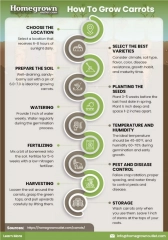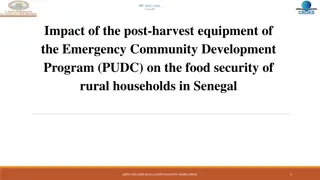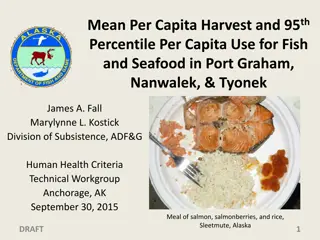Post Harvest Methods in Cucurbits - Importance and Techniques
Different types of fruits and vegetables are grown in India due to varied agro-climatic conditions. India, being the second largest producer globally, faces significant post-harvest losses. Improper management practices such as careless harvesting, inadequate storage facilities, and processing methods contribute to these losses. Post-harvest technology plays a crucial role in reducing spoilage and maximizing crop utilization in a safe and nutritious manner. Various techniques like low-temperature preservation, chemical preservation, and thermal processing are employed to minimize losses. Maturity standards and quality characteristics in muskmelons are vital considerations for successful post-harvest handling. Understanding the ripening process of climacteric fruits like muskmelon is key to ensuring optimal quality during storage and transport.
Uploaded on Sep 13, 2024 | 0 Views
Download Presentation

Please find below an Image/Link to download the presentation.
The content on the website is provided AS IS for your information and personal use only. It may not be sold, licensed, or shared on other websites without obtaining consent from the author.If you encounter any issues during the download, it is possible that the publisher has removed the file from their server.
You are allowed to download the files provided on this website for personal or commercial use, subject to the condition that they are used lawfully. All files are the property of their respective owners.
The content on the website is provided AS IS for your information and personal use only. It may not be sold, licensed, or shared on other websites without obtaining consent from the author.
E N D
Presentation Transcript
Post harvest methods in cucurbits G.HARIKA
Post harvest methods in cucurbits
Due to varied agro-climatic conditions, different types of fruits and vegetables are grown in India and at present India is the second largest producer of fruits and vegetables in the world. However, the huge post harvest losses to the tune of 30-40% occur every year owing to the improper post harvest management practices. The careless harvesting, improper loading and inadequate storage and processing facilities are the major factors which cause the post harvest losses in India.
Post harvest technology- importance and role The post harvest technology of vegetable crops envisages the developing of appropriate techniques to reduce post harvest losses to prevent spoilage and help utilize maximum crops, in a nutritious and safe manner. To reduce the losses, we must understand the biological and environmental factors involved in deterioration of the perishables, and secondly to use the post harvest technological procedures to achieve the same
The processing itself includes several techniques such as low temperature preservation, chemical preservation, irradiation, thermal processing, dehydration and high pressure processing and preservation by fermentation.
Muskmelon Maturity standards: The fruits when mature slip out easily from the vine with a little pressure or Jerk or if not, remain separated the next day. This is called full slip stage.
The quality characteristics in muskmelon are several and varied namely thick skin and netting suitable for long distance hauling, juicer flesh with at least 10% TSS.
Muskmelon is a climacteric fruit, which ripens during transit and storage and hence it is harvested before it is fully ripe so that it well reach the consumer at full ripe condition. More juicier the flesh the less will be the keeping quality of the whole fruit. Firmer flesh stands transport well
Post harvest management: The cucurbits are not usually processed. Similarly muskmelon is not generally processed except the flesh of muskmelon is used in ice-cream in western countries. On small scale the juice of muskmelon flesh could be prepared; however, it has to be consumed within short time because ( does not have any storage quality.
Marketing: Muskmelon especially can be hauled to the long distance metropolitan markets of Bombay (from A.P) Calcutta (from UP) and Delhi (from Rajasthan, Lucknow etc). Muskmelon transported in trucks without any individual packing and are liable to bruises and damage transit.
Storage Muskmelon (full lip stage) can be stored for 2-3 days Period of storage can be increased by lowering the storage temperature at 0 C at 80-90%RH. Muskmelon and watermelon are transported in trucks without any individual packing and are liable to bruises and damage during transit. Musk melon is sensitive to ethylene and should not be stored or shipped with ethylene producing commodities.
Cucumber Marketing : In cucumber crook neck shaped fruits produced especially at the fag end of the harvest would have less marketable value. These fruits are produced because of imperfect pollination and fertilization and also due to fly attack. Other consideration in harvesting of cucumber is the distance of the market; cucumber does not stand much to long distance transportation.
In rainy season crops or crops damaged by summer rains, fly attacked fruits would be considerable which will have to be culled out before sending to market.
In fact, cucumber has to be sold out in heavy urban markets. Cucumbers are packed in baskets and transported. Being highly perishable, marketing of cucumber involves risks and losses and hence its cultivation is concentrated around the metropolitan cities.
Storage : ' For good storage life, optimum temperature is near -10 C & RH of 85%. Cucumbers can be stored for 10-14 days Chilling Injury is a physiological storage disorder when fruits are exposed to temperature below -IO C for prolonged period. is moderately resistant
Laamin et al.(1995) reported that modified atmosphere storage of cucumbers significantly reduced weight loss, maintained fruit colour, firmness and acidity and doubled the shelf-life Ceramic film of 0.02 mm thickness was the best for maintaining fruit quality during modified atmosphere storage of cucumber. Shelf-life of about 2 weeks at 4 C has been reported by Huyskens et al. (1993) in cucumber
Cucumber fruits can be stored at 12.5C without risks to fruit quality and it developed symptoms of chilling injury when stored at 2.5 C Most of the cucurbits in India are not stored, except pumpkin and ash gourd and no cold storage facility is available in this country for these vegetables.
watermelon Maturity standards : In water melon, maturity is judged by taking into consideration several factors. Dull sound when the fruit is thumped in contrast to metallic sound. Withering of tendril at the fruit axil Ground spot (Where the fruit touches the ground) turning yellow.
4. Rind of the ripe melon yields to presume. Cumulatively all these criteria will help to judge the fruit for picking. Most of the cultivars have deep pink or pink or pale pink flesh colour with slightly reddish tinge containing largely lycopene and anthocyanin pigments. The average sweetness will record around 9-10% TSS.
Post harvest management: The cucurbits are not usually processed. Similarly muskmelon is not generally processed except the flesh of watermelon is used in ice-cream in western countries. On small scale the juice of muskmelon flesh could be prepared; however, it has to be consumed within short time because it does not have any storage quality
Marketing and storage: Especially in rainy season crops or crops damaged by summer rains, fly attacked fruits would be considerable which will have to be culled out before sending to market. Anthracnose affected fruits of watermelon are of poor quality. Most of the cucurbits do not stand long transportation. Watermelon is transported in trucks without any individual packing and are liable to bruises and damage during transmit.
Being highly perishable, marketing of cucurbits involve risks and losses and hence cultivation of these vegetables are more concentrated around metropolitan cities. Some far flung river bed growing supply watermelon to the distant markets. Watermelons require careful handling as they are easily damaged and they cannot be stored may then 2-3 weeks.
Pumpkin Harvesting: Reach maturity in about 75-180 days after seed sowing Better to harvest at tender stage as a vegetable, this increases the yield But for storage and seed extraction, it should be harvested only after full maturity
Fully matured fruit have to be harvested after the skin colour has turned completed brown from green colour and the pedicel (fruit stalk) separates from the vine or dried Fully matured fruits have a long storage- life and they can also be transported easily to distant markets
After harvesting pumpkins, the most important factor in preserving pumpkin quality is storage temperature. The ideal storage temperature is between 50 F to 60 F. This temperature range is usually not feasible for most growers with a six to eight week marketing season. Generally, healthy, disease free, fully mature, dry fruit can be preserved quite well with fluctuating temperatures between 35 F and 70 F, which can be achieved in a well ventilated shed that limits direct sun exposure and provides frost protection.
Since pumpkins are a popular cash crop for apple producers, it is important to remind growers that storing pumpkins with apples is not a good idea. Stored apples emit ethylene gases that accelerate the ripening process and will potential lead to over mature pumpkins and premature breakdown
Waxing: By protecting against moisture loss and contamination, wax coatings help fresh vegetables to maintain wholesomeness and freshness. Waxing does not improve the quality. It reduces respiration and transpiration rates. Commodities that may have coatings applied include cucumbers, squash, melons, pumpkins.
Bitter gourd Storage: After harvesting remove all fruits affected with insect pests or diseases and deformed ones. The harvested fruits cannot be kept for long time and to be sent to market as soon as possible. By sprinkling water over the fruits, freshness can be maintained for sometime in the initial stage. Fruits can be packed in polypropylene bag for extended shelf-life.
Bottle gourd Storage: Fruits can be stored for 3-5 days under cool and shady conditions Marketing: For local markets, fruits are kept in basket or crate and then marketed. For export marketing the fruits should be picked at edible stage and then packed in polythene pipe bags and these bags are kept in boxes of 50-100kg capacity. These boxes are then transported to marketing areas.
Bottle gourd fruits (cv. Samrat) packed in polyethylene bags + CFB boxes and stored in a cool chamber (20.16-21.18 C and 90.25-94.50% RH) had the longest storage life (28 days).
The other consideration in harvesting of cucurbits is the distance of the markets. Most of the cucurbits do not stand long transportation. In fact long or serpent melon, Indian squash or round melon (tinda), cucumber, bottle gourd, etc., have to be sold out in nearby urban markets.
Ridge and sponge gourd Storage and marketing: Harvesting should be done at proper edible maturity. Grading of fruits should be done according to size. The fruits are packed in separate baskets. Care should be taken that the fruits should not have any injury during transit. The fresh and tender fruits should reach the consumer.
Fruits harvested at the marketable stage can be stored for 3-4 days in a cool place without any adverse effects. The fruits are packed in bamboo baskets with proper padding to prevent injury in transit. The fruits are marketed in local and distant markets. The plastic crates are also used for packing of fruits
By dipping in benzyladenine at 50 mg/1 fruits of ridge gourd cv. HRQ-14 could be stored for 9 days at 0.5 C with least physiological weight loss, lowest decay and the best fruit quality
Ash gourd Storage: Ash gourd can be stored longer than any other cucurbits
Snake gourd Storage and marketing: Shelf-life: Two days Generally the whole fruits are packed and then sent to the markets
squash fruits (C. moschata) stored at 12C showed no chilling injury symptoms after 20 days of storage but did not show any increase in marketability due to accelerated quality deterioration after 10 days in storage
Recommended storage temperatures and RH Vegetables Temperatur e (o c) RH (%) Storage life (weeks) Bitter gourd 0.6-1.7 85-90 4 Cucumber 10.0-11.7 92 2 Pumpkin 1.7-11.6 70-75 24-36 Winter squash Watermelon 12.8-15.6 70-75 24-36 7.2-15.6 80-90 2























